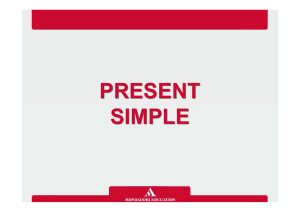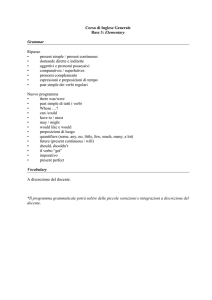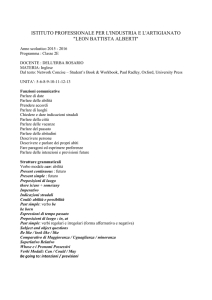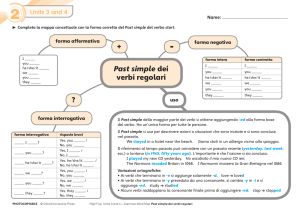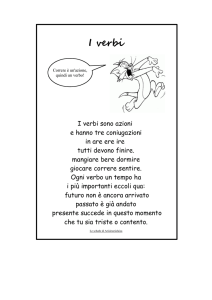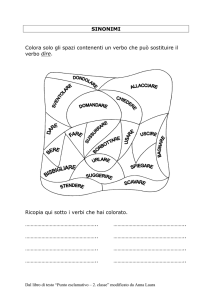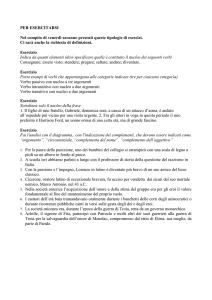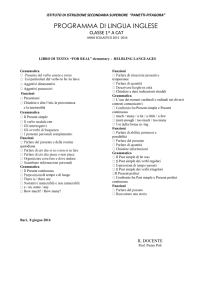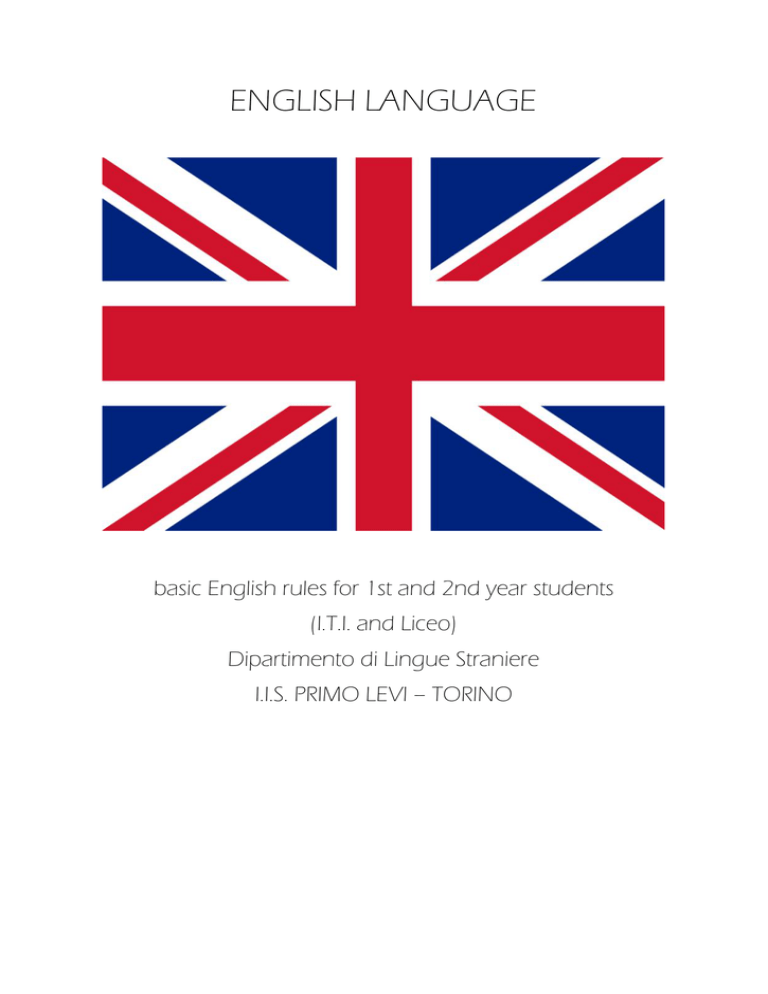
ENGLISH LANGUAGE
basic English rules for 1st and 2nd year students
(I.T.I. and Liceo)
Dipartimento di Lingue Straniere
I.I.S. PRIMO LEVI – TORINO
IIS Primo Levi
Basic English biennio
1. IL PRESENTE
1.1 VERBO TO BE (ESSERE):
forma
affermativa
I
HE/SHE/IT
WE/YOU/THEY
Am/’m
Is/’s
Are/’re
forma
negativa
I
Am
not/’m
not
Is not/isn’t
Are not/aren’t
HE/SHE/IT
WE/YOU/THEY
forma
interrogativa
Am
Is
Are
I?
HE/SHE/IT?
WE/YOU/THEY?
1.2 USI PARTICOLARI di TO BE:
be afraid--be hot/cold--be hungry--be thirsty--be in a hurry--be right/wrong---
aver paura
aver caldo/freddo
aver fame
aver sete
aver fretta
aver ragione/torto
1.3 HAVE GOT (AVERE, POSSEDERE)
forma
affermativa
I/WE/YOU/THEY
HE/SHE/IT
forma
negativa
I/WE/YOU/THEY
HE/SHE/IT
forma
interrogativa
Have got/’ve
got
Has got/’s got
Have not got/
haven’t got
Has not got/
Hasn’got
Have I/WE/YOU/THEY got?
Has HE/SHE/IT got?
2
IIS Primo Levi
Basic English biennio
HAVE non accompagnato da GOT NON è un verbo ausiliare e si comporta come gli altri verbi non
ausiliari (v. seguito). Assume inoltre altri significati:
have breakfast/lunch/dinner---
far colazione, pranzo, cena
have a bath, a shower---
fare il bagno, la doccia
1.3 IL PRESENT SIMPLE DEI VERBI NON AUSILIARI
Il Present Simple si forma con l’infinito senza il to:1
I/YOU/WE/THEY work
HE/SHE/IT works
Alla 3^ pers. Singolare si aggiunge –s. Con i verbi terminanti in o, s, ch, sh, x si aggiunge –es
Ex: He watches she goes, he relaxes, she misses, he wishes…..
Con i verbi terminanti in –y preceduta da consonante, si toglie –y e si aggiunge –ies:
she studies – he tries…. MA: she plays
AVVERBI DI FREQUENZA
Il Present Simple si usa per parlare di azioni abituali, perciò si usano spesso con avverbi di
frequenza come:
always - sempre
usually - di solito
often – spesso
sometimes – talvolta
rarely – raramente
never – mai
L’avverbio di frequenza si posiziona tra il soggetto e il verbo:
I always go to work by bus
TRANNE nel caso del verbo TO BE:
I am never late
1.4 FORMA NEGATIVA
I/YOU/WE/THEY play football – negativa: I/YOU/WE/THEY DON’T play football
He/SHE/IT plays football – negativa: HE/SHE/IT DOESN’T PLAY football
1
L’infinito senza il to si chiama “forma base” del verbo
3
IIS Primo Levi
Basic English biennio
L’ausiliare della forma negativa è DON’T per prima e seconda persona sing. e pl., DOESN’T per la
terza persona singolare.
Il verbo è sempre alla FORMA BASE.
1.5 FORMA INTERROGATIVA
DO I/YOU/WE/THEY play football?
DOES HE/SHE/IT play football ?
La domanda al simple present si costruisce con gli ausiliari DOES (3^ persona sing.) e DO (tutte le
altre) nell’ordine sopra indicato. Il verbo è sempre alla FORMA BASE.
In presenza di QUESTION WORDS (pronomi interrogativi) come where, what, who, when, why,
how… questi si posizionano PRIMA dell’ausiliare:
WHERE DO you live?
WHAT TIME DOES she start work?
1.6 IL PRESENT CONTINUOUS
Il Present Continuous si usa per parlare di azioni in corso di svolgimento nel momento in cui si
parla, o in un periodo limitato di tempo nel presente.
Si costruisce con il presente del verbo BE seguito da un verbo in –ing (gerundio):
I am writing an e-mail to my friend in America
WE/YOU/THEY are listening to the radio
HE/SHE/IT is talking on the phone.
ORTOGRAFIA
I verbi terminanti in –e perdono la –e quando si aggiunge –ing: write – writing
I verbi monosillabici terminanti in consonante preceduta da vocale raddoppiano la cons. finale
quando si aggiunge –ing: sit – sitting, swim-swimming, run-running….
N.B.: travel – travelling
ALCUNE ECCEZIONI
Vi sono verbi che solitamente non si usano al Present Continuous. Essi sono:
-
Verbi di stato: be, have (solo nel senso di “possedere”)
Verbi che indicano sentimenti o sensazioni: feel, love, hate, taste, smell, hear, see…
4
IIS Primo Levi
Basic English biennio
2. IL PASSATO
2.1. IL PAST SIMPLE
Il Past Simple descrive azioni, situazioni o stati nel passato e corrisponde al passato remoto in
italiano. Solitamente è accompagnato da espressioni di tempo come yesterday (ieri), last
week/month/year (la scorsa settimana/mese/anno), three years ago (tre anni fa)….
Quando si parla di Past Simple dobbiamo tenere a mente la divisione dei verbi inglesi in
REGOLARI e IRREGOLARI.
Il Past Simple dei verbi regolari si forma aggiungendo –ed alla forma base del verbo; con i verbi
che terminano in –e si aggiunge solo –d:
I enjoyed the film (da enjoy)
She loved the music (da love).
La forma del Past Simple è uguale per tutte le persone.
ORTOGRAFIA
Con i verbi regolari terminanti in –y preceduta da consonante, si toglie –y e si aggiunge –ied:
study – studied
try – tried
cry – cried
I verbi monosillabici terminanti in consonante preceduta da vocale raddoppiano la cons. finale
quando si aggiunge –ed: stop – stopped; fit – fitted.
Per quanto riguarda i verbi irregolari, essi hanno una forma a sé e non seguono le regole sopra
citate. I paradigmi dei principali verbi irregolari sono riportati alla fine di questo documento. Il Past
Simple dei verbi irregolari è rappresentato dalla seconda colonna del paradigma.
2.2. FORMA NEGATIVA
Si costruisce con did not (didn’t) seguito dal verbo alla FORMA BASE:
Ex: I enjoyed playing football yesterday--- Mi sono divertito a giocare a calcio ieri
I didn’t enjoy playing football yesterday---Non mi sono divertito a giocare a calcio ieri
We went to the seaside last year--- Siamo andati al mare l’anno scorso
We didn’t go to the seaside last year--- Non siamo andati al mare l’anno scorso
Did not/didn’t è uguale per tutte le persone.
2.3. FORMA INTERROGATIVA
DID I/YOU/WE/THEY/ HE/SHE/IT play football?
La domanda al Past Simple si costruisce con l’ausiliare DID per tutte le persone nell’ordine sopra
indicato. Il verbo è sempre alla FORMA BASE.
5
IIS Primo Levi
Basic English biennio
In presenza di QUESTION WORDS (pronomi interrogativi) come where, what, who, when, why,
how… questi si posizionano PRIMA dell’ausiliare:
WHERE DID you live when you were a child?--- Dove vivevi da bambino?
WHAT TIME DID she start work yesterday?--- A che ora ha iniziato (lei) a lavorare ieri?
2.4 IL PAST SIMPLE DI TO BE
Il verbo BE è irregolare. La forma del Past Simple è:
forma
affermativa
I/HE/SHE/IT
WE/YOU/THEY
was
were
forma
negativa
I/HE/SHE/IT
Was
not
(wasn’t)
Were not
(weren’t)
WE/YOU/THEY
forma
interrogativa
Was
Were
I/ HE/SHE/IT?
WE/YOU/THEY?
Ex: I was at the cinema last night--- Ero al cinema ieri sera
I was not (wasn’t) at the cinema last night--- Non ero al cinema ieri sera
Were you at the restaurant yesterday at 9 p.m.?
2.5. IL PRESENT PERFECT
Il Present Perfect ricorda il passato prossimo italiano. Si forma con l’ausiliare have e oil participio
passato del verbo.
Ex: I/YOU/WE/THEY have played – HE/SHE/IT has played
I/YOU/WE/THEY haven’t played - HE/SHE/IT hasn’t played
Have I/YOU/WE/THEY played? Has HE/SHE/IT played?
Per i verbi REGOLARI il participio passato si forma aggiungendo –ed alla forma base (stesse
regole del Past Simple): per i verbi irregolari è la terza colonna del paradigma (vedere al fondo).
Il Present Perfect si usa in inglese nei seguenti casi:
-
Azioni iniziate nel passato che continuano nel presente:
6
IIS Primo Levi
-
-
Basic English biennio
Ex: I’ve lived in Turin for 10 years--- Vivo a Torino da 10 anni (ho iniziato a vivere qui 10
anni fa e ci vivo ancora); I’ve lived in Turin since 2005--- Vivo a Torino dal 2005in questo
caso il Present Perfect è accompagnato da for (per) o since (da, dal)
Per parlare di esperienze senza che venga indicato un tempo preciso:
I’ve never been in India--- Non sono mai stato in India
Have you ever been to Russia? Sei mai stato in Russia?
In questi casi il Present Perfect è spesso accompagnato da never e ever (= mai, il primo si
usa nelle frasi affermative, il secondo nelle domande)
Azioni recenti:
Ex: I’ve just finished my homework--- Ho appena finito i compiti
I’ve already read this book--- Ho già letto questo libro
I haven’t cooked dinner yet--- Non ho ancora cucinato la cena
In questo caso il Present Perfect si usa con avverbi come just (=appena), already (=già) che
si usano nelle frasi affermative tra have e il participio passato e yet (=non ancora) usato in
frasi negative e che si posiziona al fondo della frase.
2.5 PAST SIMPLE E PRESENT PERFECT.
Si usa il PAST SIMPLE quando ci si riferisce ad un tempo COMPLETAMENTE TRASCORSO
(yesterday, two weeks ago, last month…), oppure PER PARLARE DI FATTI STORICI O
REMOTI.
Si usa il PRESENT PERFECT quando ci si riferisce AD UN TEMPO NON DEL TUTTO
TRASCORSO o SE NON VI SONO RIFERIMENTI ESPLICITI DI TEMPO.
3. IL FUTURO
3.1 DIVERSI TIPI DI FUTURO
Ci sono diversi modi per esprimere il futuro in inglese a seconda di come esso viene inteso:
a. Se parliamo di PROGRAMMI DEFINITI, appuntamenti di cui sappiamo giorno, ora, ecc.
usiamo il PRESENT CONTINUOUS con valore di futuro.
Ex: I’m meeting Sarah tomorrow at 4 p.m.--- Incontrerò Sarah domani pomeriggio alle 4
(per come si costruisce il Present Continuous, v.par. 1.6);
b. Se parliamo di orari (di treni, bus, aerei, spettacoli, negozi….) usiamo il Present Simple con
valore di futuro
Ex: the shop closes at 6--- Il negozio chiuderà alle 6
(per come si costruisce il Present Simple, v.parr. 1.3 – 1.5)
c. Se parliamo di INTENZIONI di fare qualcosa nel futuro o di PREVISIONI basate su
CERTEZZE OGGETTIVE usiamo il costrutto to be going to
Ex: When I am 18, I’m going to take a driving licence--- Quando avrò 18 anni, ho
intenzione di prendere la patente
7
IIS Primo Levi
Basic English biennio
Look at those clouds! It’s going to rain!--- Guarda quelle nuvole! Sta per piovere!
d. Se vogliamo esprimere PREDIZIONI non basate su certezze o DECISIONI PRESE SUL
MOMENTO che riguardano il futuro usiamo il costrutto con will
Ex: You will be rich and lucky--- Sarai ricco e fortunato
I’ll be at home tomorrow. Ok, I’ll come and visit you!--- Sarò a casa domani. Ok verrò a
farti visita.
Il futuro dei verbi si accompagna sempre con avverbi di tempo futuro come:
tomorrow--- domani
next week/month/year…--- la prossima settimana/il prossimo mese/anno
this week/month/year…----questa settimana/questo mese/anno
3.2. TO BE GOING TO
Forma affermativa
I
AM
YOU/WE/THEY
ARE
HE/SHE/IT
IS
GOING TO
STUDY
medicine
I
AM NOT
YOU/WE/THEY
ARE NOT GOING TO
STUDY
medicine
HE/SHE/IT
IS NOT
Forma negativa
Forma interrogativa
AM
I
ARE YOU/WE/THEY
IS
GOING TO
STUDY
medicine?
HE/SHE/IT
Il verbo (in questo caso study) è sempre alla FORMA BASE.
Examples:
-
-
He’s going to buy a scooter when he has enough money--- Ha intenzione di comprare uno
scooter quando avrà abbastanza denaro (N:B: : dopo when, before, after, as soon as in
questo tipo di frasi il verbo è al present simple)
Look! Those books are going to fall!--- Guarda! Quei libri stanno per cadere!
8
IIS Primo Levi
-
Basic English biennio
Don’t worry! We aren’t going to crash! ____________________________ (traduci)
Are you going to be a doctor when you grow up? ______________________ (traduci).
3.3. IL FUTURO CON WILL
Forma affermativa
I
YOU/WE/THEY
WILL (‘LL) BE
late tonight
HE/SHE/IT
Forma negativa
I
YOU/WE/THEY
WILL NOT
(WON’T) BE late tonight
HE/SHE/IT
Forma interrogativa
I
WILL YOU/WE/THEY
BE
late tonight?
HE/SHE/IT
N.B. WILL è uguale per tutte le persone
Alla forma negativa si contrae in WON’T, a quella affermativa in ‘LL (solo con i pronomi)
Il verbo che segue WILL (in questo caso BE) è sempre alla FORMA BASE.
Ex. They won’t be here tomorrow.---- Non saranno qui domani.
Will I be pretty? Will I be rich? ________________________________(traduci)
Manchester United will surely win tomorrow ____________________________(traduci)
9
IIS Primo Levi
Basic English biennio
4. I VERBI MODALI
Caratteristica dei verbi modali, o difettivi, è quella di “difettare” cioè mancare, di alcune forme.
I più comuni sono:
can (potere, essere capace di)
must (dovere)
may, might (potere, avere il permesso di).
I verbi modali:
-
Sono uguali per tutte le persone (I/YOU/HE/SHE/IT/WE/YOU/THEY can, ecc.)
Non prendono la –s alla terza persona singolare.
La forma negativa si costruisce aggiungendo not, quella interrogativa con l’inversione
soggetto/verbo (come il verbo be)
Ex: I can play the piano well--- so suonare bene il piano
Can you cook?--- Sai cucinare?
She cannot (can’t) ski--- Lei non sa sciare
British students must wear a uniform--- Gli studenti britannici devono indossare l’uniforme
May I open the window?--- Posso aprire la finestra?
N.B.: il Past Simple di can è was/were able to: She was able to play the piano well
il Past Simple di must è had to: We had to wear a uniforma at school
5. IL PERIODO IPOTETICO DI I TIPO
Questo tipo di frase si riferisce ad una condizione reale, nel senso che chi parla descrive ciò che
accadrà in una situazione reale, non immaginaria.
Il Periodo ipotetico si compone di una subordinata ipotetica (introdotta da if= se, when=quando,
until=finchè) e di una proposizione principale.
If we walk so slowly, we’ll be late --- Se camminiamo così lentamente arriveremo in ritardo.
Nel PERIODO IPOTETICO DI I TIPO la subordinata ipoteticaha sempre il verbo al PRESENT
SIMPLE, la principale invece SEMPRE AL FUTURO CON WILL.
We won’t be late if we run. ________________________________ (traduci)
When I see hera gain, I’ll tell your news ______________________(traduci)
You’ll pass the exam if you study hard _______________________(traduci).
APPENDICE
10
IIS Primo Levi
Basic English biennio
Elenco dei principali verbi irregolari
11

